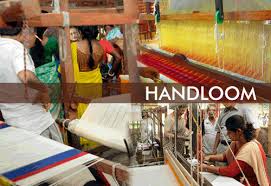It is the endeavor of the Government to save and develop the handloom sector in the country. Keeping this in view, the Government of India is implementing the following schemes across the country for development of handloom sector and welfare of handloom weavers: –
- National Handloom Development Programme (NHDP)
- Comprehensive Handloom Cluster Development Scheme (CHCDS)
- Handloom Weavers’ Comprehensive Welfare Scheme (HWCWS)
- Yarn Supply Scheme (YSS)
Under the above schemes, financial assistance is provided for raw materials, purchase of looms and accessories, design innovation, product diversification, infrastructure development, skill upgradation, lighting units, marketing of handloom products and loan at concessional rates.
1.National Handloom Development Programme (NHDP)
- Block Level Cluster: Introduced in 2015-16 as one of the components of National Handloom Development Programme (NHDP). Financial assistance upto Rs. 2.00 crore per BLC for various interventions such as skill upgradation, Hathkargha Samvardhan Sahayata, product development, construction of workshed, project management cost, design development, setting up of common facility centre (CFC) etc. is provided. Besides, financial assistance upto Rs. 50.00 lakh is also available for setting up of one dye house at district level. The proposals are recommended by the State Government.
- Handloom Marketing Assistance is one of the components of National Handloom Development Programme. In order to provide marketing platform to the handloom agencies/weavers to sell their products directly to the consumers, financial assistance is provided to the States/eligible handloom agencies for organizing marketing events in domestic as well as overseas markets.
- Weaver MUDRA Scheme: Under the Weaver MUDRA Scheme, credit at concessional interest rate of 6% is provided to the handloom weavers. Margin money assistance to a maximum of Rs. 10,000 per weaver and credit guarantee for a period of 3 years is also provided. MUDRA Portal has been developed in association with Punjab National Bank to cut down delay in disbursement of funds for margin money and interest subvention.
- HATHKARGHA SAMVARDHAN SAHAYATA (HSS):
Hathkargha Samvardhan Sahayata (HSS) was introduced on 1st December 2016 with an objective to provide looms/accessories to the weavers to enhance their earnings through improved productivity and quality of the handloom products. Under the scheme, 90% of the cost of loom/accessory is borne by the Government of India while remaining 10% is borne by the beneficiary. The Government of India’s share is released to the supplier through Weavers’ Service Centre.
- EDUCATION OF HANDLOOM WEAVERS AND THEIR CHILDREN:
Ministry of Textiles has signed Memorandums of Understanding with Indira Gandhi National Open University (IGNOU) and National Institute of Open Schooling (NIOS) to secure educational facilities for the weavers and their families. NIOS offers Secondary and Senior Secondary level education with specialized subjects on design, marketing, business development, etc. through distance learning mode for handloom weavers, whereas IGNOU offers continuing education programs through accessible and flexible learning opportunities relevant to the aspirations of handloom weavers and their children for career progression.
The programme envisages reimbursement of 75% of the fee towards admission to NIOS/IGNOU courses in case of SC, ST, BPL, and Women learners belonging to handloom weavers’ families.
- “India Handloom” Brand– During the celebration of 7th August 2015 as National Handloom Day, ‘India Handloom’ Brand was launched by Hon’ble Prime Minister for branding of high quality handloom products. It promotes production of niche handloom products with high quality, authentic traditional designs with zero defect and zero effect on environment. Since its launch, 1590 registrations have been issued under 184 product categories and sale of Rs. 926.23 crore has been generated.
Initiatives with various leading brands has been undertaken to bring out a separate range of handloom garments in their brand.
- E-COMMERCE– In order to promote e-marketing of handloom products, a policy frame work was designed and under which any willing e-commerce platform with good track record can participate in online marketing of handloom products. Accordingly, 23 e-commerce entities have been engaged for on-line marketing of handloom products. A total sales of Rs. 110.46 crore has been reported through the online portal.
- URBAN HAATS are set up in the big towns/metropolitan cities to provide adequate direct marketing facilities to the craft persons/weavers and eliminate middle agencies. 39 such Urban Haats have been sanctioned across the country so far.
2. Comprehensive Handloom Cluster Development Scheme:
The Comprehensive Handloom Cluster Development Scheme (CHCDS) is targeted at development of Mega Handloom Clusters in clearly identifiable geographical locations covering atleast 15000 handlooms with the Government of India (GoI) contribution upto Rs.40 crore per cluster over a period of 5 years. Components such as conducting diagnostic study, corpus for raw material, etc., are fully funded by the Government of India (GoI) whereas components like lighting units, technological up-gradation of looms and accessories are 90% funded by the GoI. Other components such as creation of infrastructure for design studio/ marketing complex/garmenting unit, marketing development, assistance for exports and publicity are 80% funded by the GoI. 08 Mega Handloom Clusters viz. Varanasi (Uttar Pradesh), Sivasagar (Assam), Virudhunagar(Tamil Nadu), Murshidabad (West Bengal), Prakasam & Guntur districts (Andhra Pradesh), Godda & neighbouring districts (Jharkhand), Bhagalpur (Bihar) and Trichy (Tamil Nadu) have been taken up for development.
3. Handloom Weavers’ Comprehensive Welfare Scheme
Weavers Comprehensive Welfare Scheme (HWCWS) is providing life, accidental and disability insurance coverage under the components Pradhan Mantri Jivan Jyoti Bima Yojana (PMJJBY), Pradhan Mantri Suraksha Bima Yojana (PMSBY) and Converged Mahatma Gandhi Bunkar Bima Yojana (MGBBY).
4. Yarn Supply Scheme:
Yarn Supply Scheme is being implemented throughout the country to make available all types of yarn at Mill Gate Price. The scheme is being implemented through National Handloom Development Corporation. Under the Scheme freight is reimbursed and depot operating charges @2% is given to depot operating agencies. A component of 10% price subsidy also exists on hank yarn, which is applicable on cotton, domestic silk, wool and linen yarn with quantity caps.
There is no plan to revive Janata Scheme.
This information was given in a written reply by the Union Minister of Textiles Smt. Smriti Zubin Irani in Rajya Sabha today.

